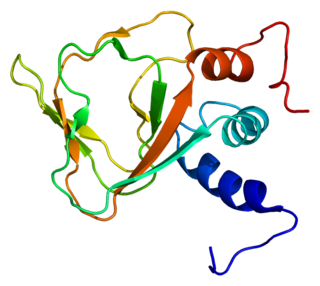
Ras-related protein Rap-1A is a protein that in humans is encoded by the RAP1A gene.

Olfactory receptor 1J4 is a protein that in humans is encoded by the OR1J4 gene.

Olfactory receptor 5K1 is a protein that in humans is encoded by the OR5K1 gene.

Olfactory receptor 1N1 is a protein that in humans is encoded by the OR1N1 gene.

Olfactory receptor 5C1 is a protein that in humans is encoded by the OR5C1 gene.

Ras-related protein Rab-5C is a protein that in humans is encoded by the RAB5C gene. RAB5C belongs to the Ras-related protein family.

Rap guanine nucleotide exchange factor 5 is a protein that in humans is encoded by the RAPGEF5 gene.

RCC1 and BTB domain-containing protein 2 is a protein that in humans is encoded by the RCBTB2 gene.

Rap guanine nucleotide exchange factor 6 is a protein that in humans is encoded by the RAPGEF6 gene.

Ras-related protein Rab-8B is a protein that in humans is encoded by the RAB8B gene.

Dock6, also known as Zir1 is a large protein involved in intracellular signalling networks. It is a member of the DOCK-C subfamily of the DOCK family of guanine nucleotide exchange factors which function as activators of small G proteins.

Pleckstrin homology domain containing, family G member 5 (PLEKHG5) is a protein that in humans is encoded by the PLEKHG5 gene. Multiple transcript variants encoding different isoforms have been found for this gene.

RAS-like, estrogen-regulated, growth inhibitor is a protein in humans that is encoded by the RERG gene.

Olfactory receptor, family 6, subfamily C, member 75 is a protein in humans that is encoded by the OR6C75 gene.

Ras protein-specific guanine nucleotide-releasing factor 1 is a protein in humans that is encoded by the RASGRF1 gene.

Inositol monophosphatase 3 also known as inositol monophosphatase domain-containing protein 1 (IMPAD1) is an enzyme that in humans is encoded by the IMPAD1 gene.

RasGEF domain family, member 1A is a protein that in humans is encoded by the RASGEF1A gene.

RAB44, member RAS oncogene family is a protein that in humans is encoded by the RAB44 gene.

ABR, RhoGEF and GTPase activating protein is a protein that in humans is encoded by the ABR gene.

Pleckstrin homology and RhoGEF domain containing G3 is a protein that in humans is encoded by the PLEKHG3 gene.





















